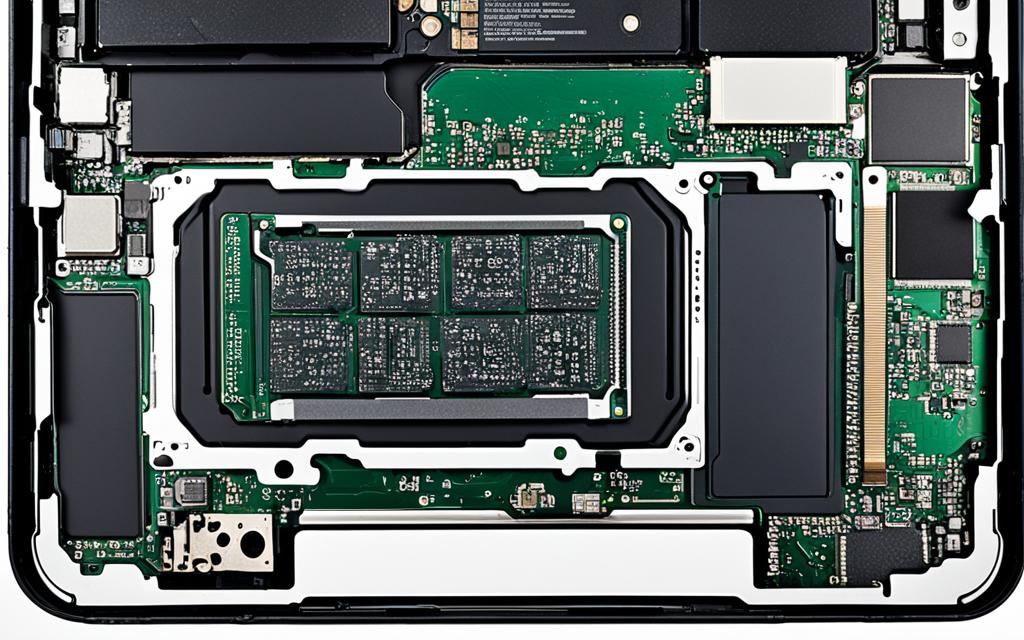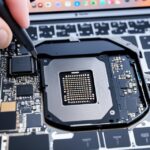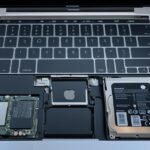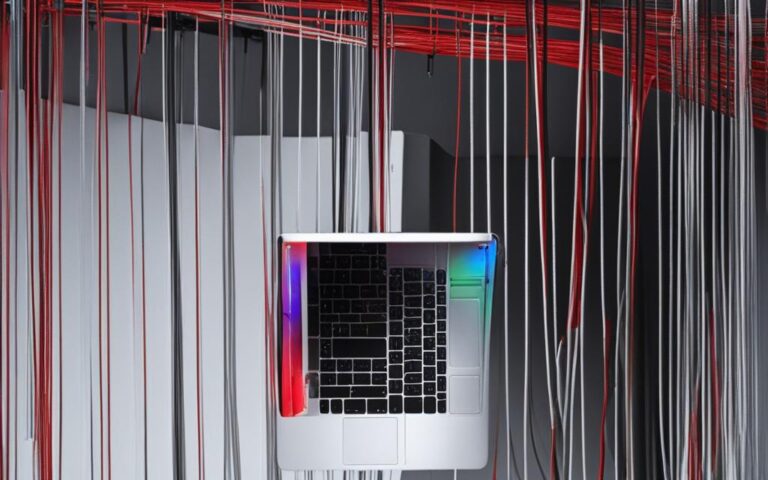MacBook Air SSD Upgrade Instructions
When upgrading the SSD on your MacBook Air, it’s important to follow the proper instructions to ensure a seamless process. By upgrading your SSD, you can enhance the speed and storage of your MacBook Air. This article provides step-by-step instructions tailored for UK users.
Are you ready to boost the performance of your MacBook Air? Upgrading the SSD is a great way to achieve faster speeds and increase storage capacity. Whether you’re a student, professional, or casual user, this guide will walk you through the process, ensuring a successful SSD upgrade for your MacBook Air in the UK.
Choosing the Right SSD Blade for Your MacBook Air
When it comes to upgrading the SSD on your MacBook Air, selecting the right SSD blade is crucial to ensure optimal performance and storage capacity. Several factors need to be considered, including compatibility, capacity, and the need for a cloning kit.
If you’re looking for an SSD blade that is compatible with your MacBook Air and offers a range of capacities, there are several options available from reputable sources. These SSD blades are specifically designed for Apple devices, ensuring seamless integration and reliable performance. Capacities range from 480GB to 2TB, allowing you to choose the storage capacity that best suits your needs.
One of the key considerations when choosing an SSD blade is whether or not you require a cloning kit. If you’re starting with a fresh installation of macOS and do not need to transfer any existing data, a cloning kit may not be necessary. However, if you plan on restoring your data from a Time Machine backup or cloning your current data onto the new SSD, it’s essential to have the right tools at hand.
Some of the tools that may be required for the installation process include a Pentalobe screwdriver and a Torx T5 screwdriver. These tools allow you to safely open your MacBook Air and replace the SSD blade without causing any damage to the internal components.
Summary Table: SSD Blade Options for MacBook Air
| SSD Blade | Compatibility | Capacity | Cloning Kit |
|---|---|---|---|
| SSD Blade A | Apple Compatible | 480GB | No |
| SSD Blade B | Apple Compatible | 1TB | Yes |
| SSD Blade C | Apple Compatible | 2TB | Yes |
As seen in the table above, there are SSD blade options available for MacBook Air users. Each option is Apple compatible and offers different capacities. Furthermore, some SSD blades come with a cloning kit, which can be beneficial if you plan on cloning your existing data.
“Choosing the right SSD blade for your MacBook Air is essential to ensure a successful upgrade. Consider factors such as compatibility, capacity, and the need for a cloning kit, and select an SSD blade that meets your requirements.”
By carefully selecting the appropriate SSD blade and using the necessary tools during the installation process, you can effortlessly upgrade the storage capacity of your MacBook Air and experience improved performance for your daily tasks and workflows.
Choosing the Right Format for the New SSD
When upgrading your MacBook Air’s SSD and installing a new version of macOS, it’s crucial to ensure that the format of the new SSD is compatible with the operating system. Let’s take a look at the different formats for SSDs based on the version of macOS you are installing.
High Sierra and Later Versions
Starting with High Sierra, Apple introduced a new drive format called APFS (Apple File System). APFS is compatible with High Sierra, Mojave, Catalina, Big Sur, Monterey, and Ventura. It offers improved performance, enhanced security features, and better compatibility with modern storage technologies.
High Sierra and Earlier Versions
If you are installing High Sierra or an earlier version of macOS, it’s important to format the new SSD as Mac OS Extended (Journaled). Mac OS Extended (Journaled) is the standard file system format for older macOS versions and ensures compatibility with High Sierra, Sierra, El Capitan, and earlier versions.
Choosing the right format for your new SSD is vital to avoid any compatibility issues with the macOS version you’re installing. Ensure compatibility by formatting your SSD appropriately based on the macOS version.
| macOS Version | Recommended SSD Format |
|---|---|
| High Sierra and later | APFS |
| High Sierra and earlier | Mac OS Extended (Journaled) |
Reinstalling macOS on the New SSD
Once you’ve replaced the SSD on your MacBook Air, the next step is to reinstall macOS on the new SSD. To accomplish this, you can utilize OS Recovery, a feature that requires an internet connection. Depending on the type of installation you prefer, there are different key combinations you can use to start up your Mac in OS Recovery mode.
If you want to reinstall the latest macOS version that was previously installed on your Mac, press Command (⌘) + R during startup. This will connect your Mac to Apple’s servers and initiate the reinstallation process.
If you prefer to upgrade to the latest compatible version of macOS, press Option (⌥) + Command (⌘) + R during startup. This will download the latest macOS version that is compatible with your Mac from Apple’s servers and install it on the new SSD.
Alternatively, if you wish to reinstall the original macOS version that came with your Mac, press Option (⌥) + Shift (⇧) + Command (⌘) + R during startup. This will install the macOS version that originally shipped with your Mac.
Note: Make sure your MacBook Air is connected to a reliable internet connection before attempting any of these key combinations to ensure a smooth reinstallation process.
After completing the macOS reinstallation, you have the option to use Apple’s Migration Assistant, which allows you to transfer applications, settings, and data from another Mac or a Time Machine backup to your newly installed macOS on the upgraded SSD. Migration Assistant simplifies the process of transferring files and ensures a seamless transition to your upgraded MacBook Air.
Using Migration Assistant is straightforward:
- Connect the external device containing your applications, settings, and data to your MacBook Air.
- Launch Migration Assistant from the Utilities folder, which can be found in the Applications folder.
- Follow the on-screen prompts and select the desired options to transfer your data from the external device to your MacBook Air.
| macOS Versions | Key Combinations for OS Recovery |
|---|---|
| Reinstall the latest macOS that was installed on your Mac | Command (⌘) + R |
| Upgrade to the latest compatible macOS version | Option (⌥) + Command (⌘) + R |
| Reinstall the original macOS that came with your Mac | Option (⌥) + Shift (⇧) + Command (⌘) + R |
Backup and Recovery Options
When it comes to safeguarding your valuable data on a Mac, Apple’s built-in backup software, Time Machine, is an essential tool. Time Machine allows you to create regular backups of your Mac, ensuring that your files, applications, and system settings are protected and easily restorable if the need arises. Whether you’re facing data loss or setting up a new SSD, Time Machine has got you covered.
Automated Data Backups
Time Machine takes the hassle out of data backups by automating the process for you. It automatically creates incremental backups, capturing changes in your files and folders over time. With Time Machine, you can set up hourly backups for the past 24 hours, daily backups for the past month, and weekly backups for previous months. This intelligent backup system ensures that you always have multiple restore points to choose from, making it easy to recover your data.
Restore and Recovery Made Easy
In the unfortunate event of data loss or the need to set up a new SSD, Time Machine makes the restore and recovery process a breeze. By leveraging your Time Machine backups, you can easily restore your files, applications, and system settings to their previous state. Simply connect your backup drive, launch the Time Machine app, and browse through the intuitive interface to locate your desired files and folders. Time Machine will seamlessly restore them to your Mac, ensuring you’re back up and running in no time.
Cloning and Disk Utility
In addition to Time Machine, there are alternative backup options available to you. One such option is cloning, which involves creating an exact copy of your entire system, including the operating system, applications, and files. Cloning your Mac’s disk to an external drive allows you to create a bootable backup, providing an additional layer of data protection. Disk Utility, a built-in macOS tool, enables you to partition, format, and repair disks, making it a valuable resource for managing your backup and recovery processes.
“Cloning provides an exact replica of your system, ensuring that you have a complete backup of everything on your Mac.”
By utilizing Time Machine and exploring other backup options such as cloning and Disk Utility, you can confidently protect your data and have peace of mind knowing that your important files are safe and easily recoverable. Taking the time to establish a robust backup strategy is a proactive measure that can save you from the potential devastation of data loss. Ensure you regularly back up your Mac to mitigate the risks associated with hardware failure, accidental deletion, or software corruption.
Step-by-Step Guide for MacBook Air SSD Replacement
The process of upgrading the SSD on your MacBook Air is a relatively straightforward task that can be completed by users with minimal technical knowledge and a few essential tools. To ensure a smooth and successful SSD replacement, it is crucial to follow the step-by-step instructions provided below. However, before proceeding with the replacement process, it is essential to back up your data and confirm that the SSD is unrepairable.
Gather the necessary tools and materials
Prior to starting the SSD replacement process, make sure you have the following tools and materials:
- A compatible SSD for your MacBook Air
- A pentalobe screwdriver
- Torx T5 screwdriver
- A clean, static-free workspace
Step 1: Open the MacBook Air
Begin the SSD replacement process by carefully opening your MacBook Air. Use the pentalobe screwdriver to remove the screws securing the bottom cover. Once the screws are removed, gently lift the cover to reveal the internal components.
Step 2: Disconnect the battery
Before removing the old SSD, it is crucial to disconnect the battery to prevent any potential electrical damage. Locate the battery connector on the logic board and carefully disconnect it by gently lifting the connector straight up.
Step 3: Remove the old SSD
Once the battery is disconnected, locate the existing SSD on the logic board. Carefully remove any screws or connectors securing the SSD in place. Gently lift the old SSD from its slot and set it aside.
Step 4: Install the new SSD
Insert the new SSD into the slot previously occupied by the old SSD. Ensure that it is properly aligned and firmly seated. Secure the new SSD in place by reattaching any screws or connectors that were removed during the previous step.
Step 5: Reassemble the MacBook Air
With the new SSD securely in place, it’s time to reassemble your MacBook Air. Carefully reconnect the battery by lowering the battery connector back onto its slot on the logic board. Ensure that the connector is aligned correctly and firmly seated.
Once the battery is reconnected, place the bottom cover back onto your MacBook Air and secure it with the pentalobe screws. Tighten the screws gradually and in a diagonal pattern to ensure even pressure distribution.
Your MacBook Air is now ready to be powered on with the upgraded SSD. Boot up the system and follow the necessary setup instructions to start enjoying the improved speed and storage capacity of your MacBook Air.
Replace the old SSD with a new one to upgrade the performance and storage capacity of your MacBook Air
Conclusion
Upgrading the SSD on your MacBook Air can greatly enhance its performance and storage capacity. By following the instructions provided in this article, UK users can easily replace their SSD and enjoy a faster and more efficient MacBook Air experience. Before starting the upgrade process, it is crucial to backup your data and ensure you have the necessary tools and a compatible SSD.
Remember that a successful SSD upgrade requires careful attention to detail and following the step-by-step instructions. By taking the time to properly install a new SSD, you can maximize the lifespan of your MacBook Air and ensure its optimal functionality.
With the improved speed and increased storage space offered by an upgraded SSD, you can take full advantage of the capabilities of your MacBook Air. Whether you’re a professional needing ample space for your work files or a student looking to store a large digital library, a larger and faster SSD will meet your needs.
Upgrade your MacBook Air SSD today and enjoy a more powerful and efficient computing experience that can keep up with your demanding tasks and applications. Follow the instructions in this article, and you’ll be on your way to unlocking the full potential of your MacBook Air.












